Here is another Q & D type aid in making reproduction revolver choices for a more finely tuned impression. Meaning, not using a type before it had come out, and carrying a late 1863-1865 era revolver in 1861 for example.
No, it is not a Model 1858 Remington Army or Navy revolver…
It is a nearly universal reenactorism and commercialism that Model 1863 New Model Army's and Navy's are referred to and sold as the “Remington Model 1858.”
Eliphalet Remington had been in the gun making business since 1816 and over the next thirty-some years had built a good business in gun parts, locks, barrels, and custom-built hunting rifles. In 1845, Remington expanded their business being able to secure a failed contract given to John Griffiths of Cincinnati, Ohio for 5,000 Model 1841 Rifles. The venture went well, and pleased with the work the Ordnance Department granted them two more contracts for 7,500 M1841 Rifles each. The 15,000 were completed by 1855. In 1856, Eliphalet’s sons, Philo, Samuel, and Eliphalet Jr. joined the company and it was renamed E. Remington & Sons.
Previously, back in September 1845, Remington received a contract for the Navy side-lined from the troubled Ames Manufacturing Company to produce 1,000 of an “odd” variation of William Jenks’ breechloading carbine with a Maynard tape primer and a side “swinging” or slapper hammer. But perhaps more oddly the deal included William Jenks himself. And, along with Jenks came a mechanic, armorer, and inventor named Fordyce Beals in 1846.
Beals was, enterprising. While working on the Jenks carbine for Remington, he also interested Eli Whitney, Jr. in developing a revolver line for the Whitneyville Armory. Beals secured a patent in 1854 for a rocking arm or ‘walking beam” revolver which Whitney manufactured. But the design was complicated and not commercially viable, and ended after about 3,200 were made. Whitney then decided to sit it out and wait for Colt’s patent to expire.
In 1856 Beals designed a new pocket pistol in .31, and marketed it to Remington. With the patent “secured” by Remington, Remington started into the pistol business in 1857. Building on the concept, in September 1858 Beals was able to design a new martial pistol in .44 Army and .36 Navy featuring a means for quickly changing cylinders which Remington jumped on making roughly 15,000 Navy’s followed by 2,000-3,000 Army’s between 1860 and 1862. Between August 1861 and March 1862 7,350 Beals Navy revolvers were purchased by the U.S. Government and possibly 1,100 on the Open Market (from businesses having already bought them in numbers) although history is not clear on whether those are separate or included in the 7,350.

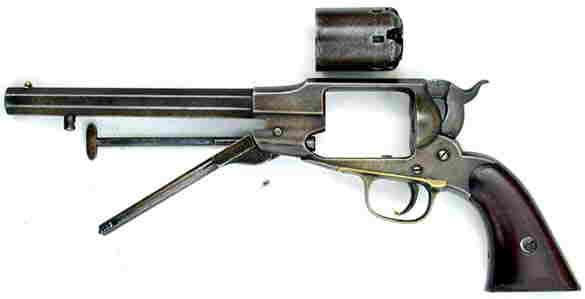

As Remington had done with the Jenks’ carbine, the name was hyphenated into the Beals-Remington revolver (Sometimes seen as Remington-Beals, sometimes just Beals). Beals for the inventor, and Remington for the manufacturer. In theory then, all future Army and Navy revolvers, the M1861 and the M1863 should have been Beals-Remington, but were not.
In August of 1861, Eliphalet Remington died. With the War going not as expected for the North, there was a tremendous demand for small arms especially revolvers. Samuel went to Washington D.C. with an offer to make revolvers for $15, ten dollars less than Colt. The Government was luke-warm and granted a contract for only 5,000. With Stanton grousing about Colt over charges, between August 1861 and March 1862 the Ordnance Department purchased 7,250 Beals Navy’s and 800 Beals Army revolvers on the open market.
That brought numbers up to 11,249 Navy’s and 850 Army’s.
One of the biggest complaints against the Beals design was in the loading lever and base pin design, centering on having to lower the loading lever first before being able to withdraw the cylinder pin to remove the cylinder. For reasons unknown to me, Beals did not answer the criticism but instead it went to William Elliott’s patent which evolved the Beals into the Remington Model 1861. Remington testified in 1862 that the revolvers already being made were based upon the Beals’ patent, but future deliveries would be based upon the Elliot patent event though for the most part it was the Beals revolver with the patents being in the loading lever.
The biggest difference was in a channel milled in the top of the loading lever that allowed the cylinder base pin (arbor) to be pulled forward to remove the cylinder without lowering the loading lever.
In June of 1862 the Ordnance Department gave Remington two contracts for 5,000 Navy’s at $12 and for 20,000 Army’s at $12 with the first 5,000 being M1861’s and the remaining 15,00 to be of a pattern to be “accepted” by Ripley.
In 1862, about 8,000 Navy’s and 12,000 Army M1861’s were made starting there serial numbers where the Beals left off.
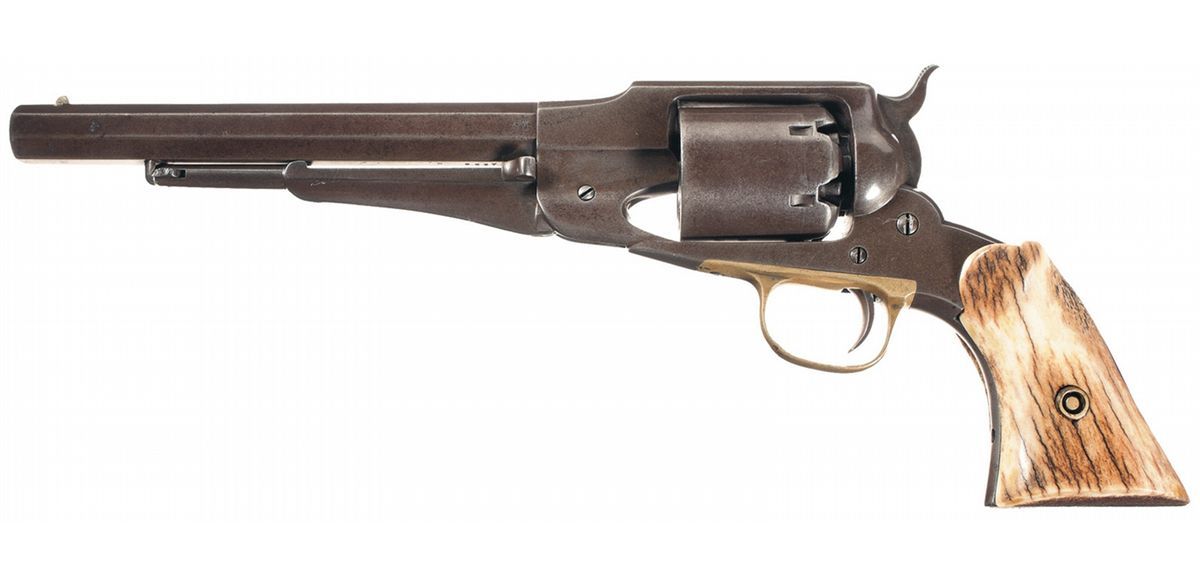
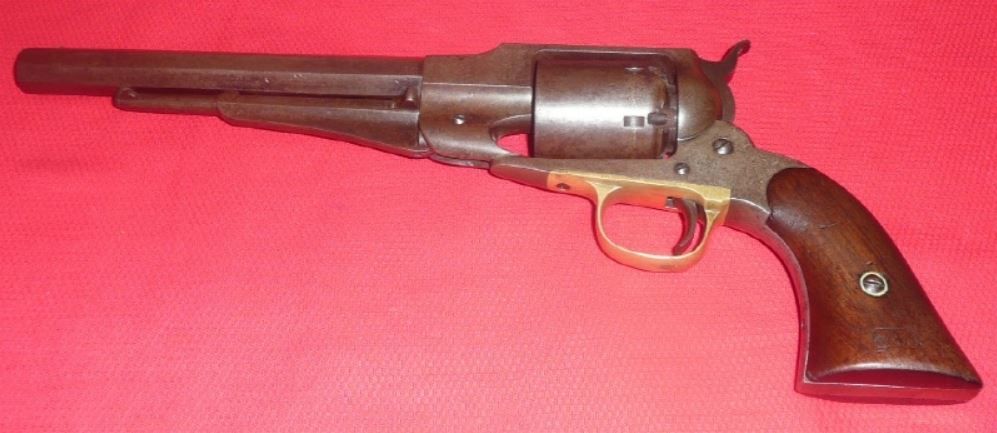
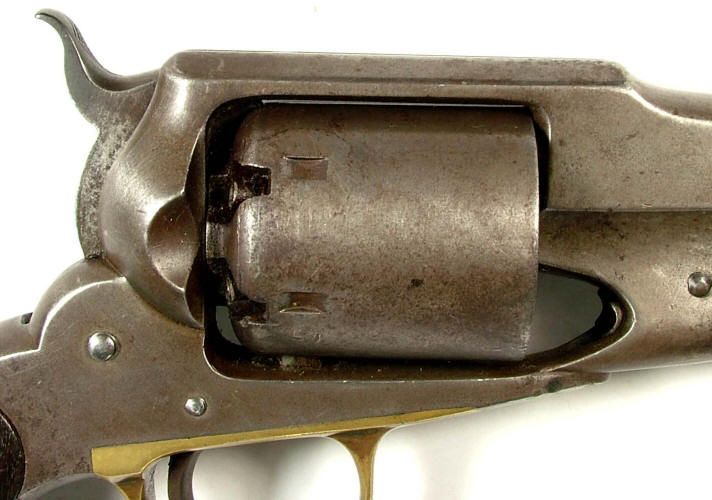
But Elliott’s patent was flawed. When the M1861 was fired in actual field use, the cylinder pin moved forward at recoil enough to jam the cylinder’s rotation and preventing firing. Once again, it appears that Beals nor Elliott resolved the problem, or Samuel Remington possibly took their employees work and registered the patent on it. In any event, Samuel Remington was granted a patent in March of 1863 making a number of changes (safety notches and pinched front sight, etc.) in addition to the cylinder base pin (arbor) resulting in a “New Model” Army and Navy revolver or the Model 1863, and making the M1861 the “Old Model” Army and Navy.
Production of the M1861’s had continued under the current contracts, but in accordance with the language switched over to the “accepted’ approved “New Model” so that the last 13,400 Army’s delivered in 1863 were the M1863 version having first come out in March. Remington was granted a new contract in July for just the M1863 versions with the Government willing to buy all Army’s made for the rest of 1863 not to exceed 20,000. By January 2, 1864, Remington had delivered 18,902 at the cost of $11.82 each.
Colt’s higher price had worn on the Ordnance Department, and by the late 1863 a decision was made to stop buying the more expensive Colt Army’s at $14.00 each and for 1864 buy only Remingtons for the majority of its needs. Eleven days after the last contract delivery of Colts in November 1863, Ramsay gave Remington a contract for 64,900 Army’s with appendages except bullet molds for $12 with a staggered monthly delivery requirement. Between January 1864 and the end of the year, Remington had delivered 57,003 revolvers on the November 1863 contract.
In addition to Colt having fallen from favored status, and having been asked to produce a solid frame revolver instead of "open tops," the Colt factory fire took Colt out of the business for 1864 and 1865. Remington’s last war time contract was given in October 1864
For 20,000 Army’s at $1550 each. Six thousand were delivered in January of 1865, 9,000 in February, and the remainder in March.
E. Remington & Sons Army revolvers purchased by the Ordnance Department:
1861. 0 Beal's
1862. 850 Beal's, July 29, 1861 contract delivered May 11, 1862
1862. 20,001 Beal's, Elliot, and New Models June 13, 1862 contract delivered July 1861 through June 1862
1863. 700 New Models that had failed inspection and been "fixed" purchased July 11, 1863 delivered July, 1863
1863. 18,208 New Models contract of July 6, 1863 delivered July through December 1863
1863. 57,005 contract of November 21, 1863 delivered January through December 1864.
1864. 20,002 New Models contract of October 24 1864 delivered January through March 1864.
Total: 116,766
(Note: references do not all agree on numbers.)
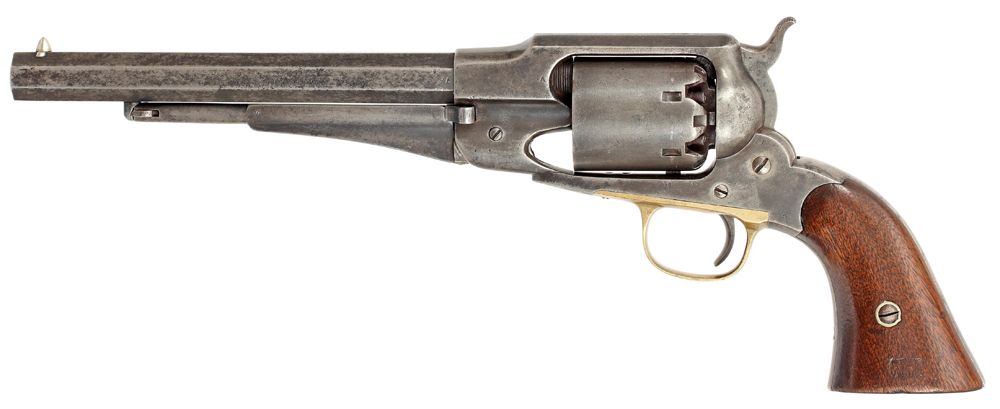
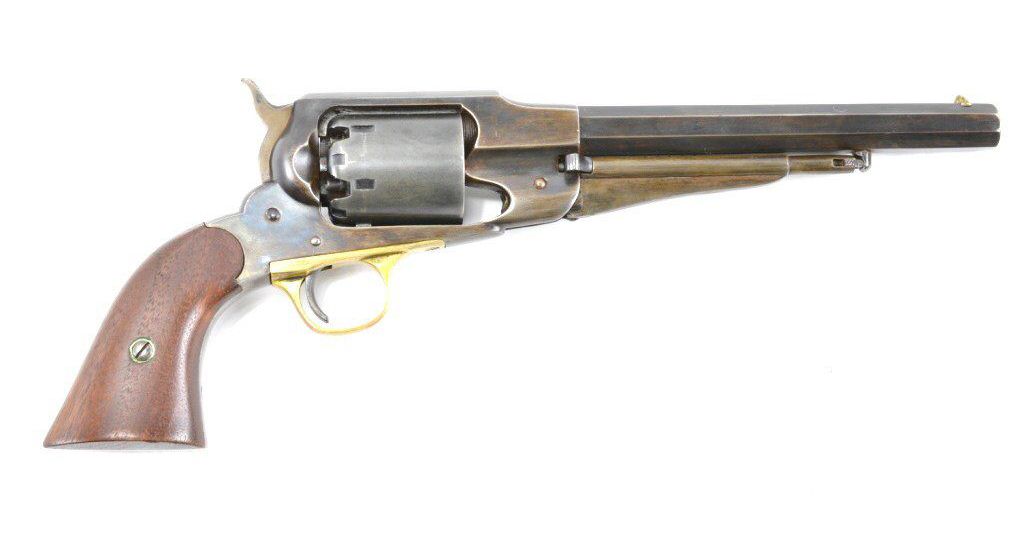

It is a nearly universal reenactorism and commercialism that Model 1863 New Model Army's and Navy's are referred to and sold as the Remington Model 1858.
The Beals (or Beals-Remington or Remington-Beals) revolvers carried Beals' patent info in the two line stamping "BEALS PATENT SEPT. 14, 1858/MANUFACTURED BY REMINGTON'S ILION, NEW YORK.

The Remington Model 1861 carried the two line stamping "PATENTED DEC. 17, 1861/MANUFACTURED BY REMINGTON'S, ILION, N.Y.
The Model 1863's were stamped in three lines “PATENTED SEPT. 14, 1858/E. REMINGTON & SONS, ILION, NEW YORK, U.S.A./NEW MODEL"
There was no official designation of "Model 1858" for the Beals or for the Remington.
Granted, they are all Beals' design so they are all similar. There are differences in the covered thread of the barrel, the hammer, the loading lever, the cylinder arbor, cylinder safety notches, front sights, etc.
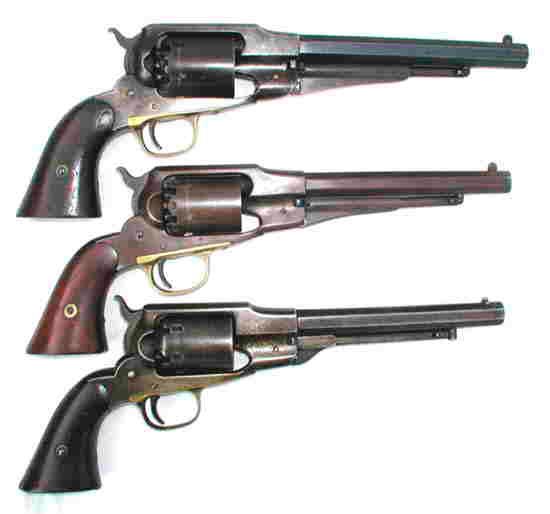
Finer points or details aside, a quick way to help tell an original Beals Army/Navy from a Remington M1861 “Old Model” Army/Navy from a Remington M1863 “New Model” Army/Navy is:
Beals. No cut out in the frame revealing barrel threads. Loading lever (Beals design) has a flat section at the bottom, and a smaller “web.” German silver cone front sight.
M1861. No cut out in the frame revealing barrel threads up to serial number 16,800. Loading lever (Elliott design) does not have a flat section at the bottom, and has a larger “web.” German silver or brass cone front sight. Cylinder arbor wing is recessed into the front of the frame.
M1863. Cut out in the frame revealing barrel threads. Loading is the Samuel Remington version and the arbor (cylinder shaft) wings recess into the front of the frame. Hammer spur is at a lower angle and does stand as tall. Early production uses the M1861 front sight, later a pinched iron one threaded into the barrel. The rear of the cylinder has safety notches. Trigger guard may be silver plated on later examples. Loading lever reverts back to the Elliott concept of not having to be lowered to remove the cylinder.
In its evolution, Remington produced the M1861 and the M1863 together for a short time. The jump from M1861 to M1863 was not abrupt, and there are about a 1,000 or so late production M1861’s that are found with some of the M1863 changes.
With the exception of the color case hardened hammers, the brass trigger guard, and the German silver or brass front sight, the Beals, M1861, and the M183 were blued. (Although it is not known why, there are a very small number of Remington’s with a color case hardened frame.
There were NO brass framed Remington M1863’s.
There is a controversy surrounding the cylinder arbor (shaft) issue that is neither clear nor borne out by the history. Plus, it can have “implications” for reenacting and living history.
One of the driving factors in the changes made to the Beals revolver focuses on having to lower the loading lever and remove the cylinder arbor or shaft in order to be able to remove the cylinder. The Colt design used a somewhat effective but crude and at times hard to adjust not to mention the risk of loss wedge or barrel key system for connecting the barrel to the frame.
In order to remove the cylinder from an “open top” Colt, one has to first remove the barrel wedge/key. It is small and losable. In order to remove the cylinder from a Beals, one had to lower the loading lever and remove the cylinder arbor.
Why the big deal?
The argument here is, that it would be easy to disable one’s revolver by dropping either the Colt barrel wedge/key or the Beals cylinder arbor from the saddle. Some interpret this issue and attempts to resolve it by Remington but NOT by Colt (until 1871) as arising from cavalrymen changing out loaded cylinders for empties in the saddle (although there is no, to date. Research or documentation that speaks to a spare cylinder being ordered, issued, or used perhaps outside of spare parts for armorers).
So, it would seem to apply to field or barracks cleanings rather than a spare loaded cylinder issue.
Because there are no reproductions of the Beals or the Model 1861 Old Models, when one sees a listing for a "Model 1858 Remington" one will receive a Model 1863 New Model.
IMHO, this reenactorism and collectorism comes from someone, somewhere, sometime not knowing any better seeing the 1858 patent date on the M1863 New Model Army and assigning it the name Remington “Model 1858”
No, it is not a Model 1858 Remington Army or Navy revolver…
It is a nearly universal reenactorism and commercialism that Model 1863 New Model Army's and Navy's are referred to and sold as the “Remington Model 1858.”
Eliphalet Remington had been in the gun making business since 1816 and over the next thirty-some years had built a good business in gun parts, locks, barrels, and custom-built hunting rifles. In 1845, Remington expanded their business being able to secure a failed contract given to John Griffiths of Cincinnati, Ohio for 5,000 Model 1841 Rifles. The venture went well, and pleased with the work the Ordnance Department granted them two more contracts for 7,500 M1841 Rifles each. The 15,000 were completed by 1855. In 1856, Eliphalet’s sons, Philo, Samuel, and Eliphalet Jr. joined the company and it was renamed E. Remington & Sons.
Previously, back in September 1845, Remington received a contract for the Navy side-lined from the troubled Ames Manufacturing Company to produce 1,000 of an “odd” variation of William Jenks’ breechloading carbine with a Maynard tape primer and a side “swinging” or slapper hammer. But perhaps more oddly the deal included William Jenks himself. And, along with Jenks came a mechanic, armorer, and inventor named Fordyce Beals in 1846.
Beals was, enterprising. While working on the Jenks carbine for Remington, he also interested Eli Whitney, Jr. in developing a revolver line for the Whitneyville Armory. Beals secured a patent in 1854 for a rocking arm or ‘walking beam” revolver which Whitney manufactured. But the design was complicated and not commercially viable, and ended after about 3,200 were made. Whitney then decided to sit it out and wait for Colt’s patent to expire.
In 1856 Beals designed a new pocket pistol in .31, and marketed it to Remington. With the patent “secured” by Remington, Remington started into the pistol business in 1857. Building on the concept, in September 1858 Beals was able to design a new martial pistol in .44 Army and .36 Navy featuring a means for quickly changing cylinders which Remington jumped on making roughly 15,000 Navy’s followed by 2,000-3,000 Army’s between 1860 and 1862. Between August 1861 and March 1862 7,350 Beals Navy revolvers were purchased by the U.S. Government and possibly 1,100 on the Open Market (from businesses having already bought them in numbers) although history is not clear on whether those are separate or included in the 7,350.



As Remington had done with the Jenks’ carbine, the name was hyphenated into the Beals-Remington revolver (Sometimes seen as Remington-Beals, sometimes just Beals). Beals for the inventor, and Remington for the manufacturer. In theory then, all future Army and Navy revolvers, the M1861 and the M1863 should have been Beals-Remington, but were not.
In August of 1861, Eliphalet Remington died. With the War going not as expected for the North, there was a tremendous demand for small arms especially revolvers. Samuel went to Washington D.C. with an offer to make revolvers for $15, ten dollars less than Colt. The Government was luke-warm and granted a contract for only 5,000. With Stanton grousing about Colt over charges, between August 1861 and March 1862 the Ordnance Department purchased 7,250 Beals Navy’s and 800 Beals Army revolvers on the open market.
That brought numbers up to 11,249 Navy’s and 850 Army’s.
One of the biggest complaints against the Beals design was in the loading lever and base pin design, centering on having to lower the loading lever first before being able to withdraw the cylinder pin to remove the cylinder. For reasons unknown to me, Beals did not answer the criticism but instead it went to William Elliott’s patent which evolved the Beals into the Remington Model 1861. Remington testified in 1862 that the revolvers already being made were based upon the Beals’ patent, but future deliveries would be based upon the Elliot patent event though for the most part it was the Beals revolver with the patents being in the loading lever.
The biggest difference was in a channel milled in the top of the loading lever that allowed the cylinder base pin (arbor) to be pulled forward to remove the cylinder without lowering the loading lever.
In June of 1862 the Ordnance Department gave Remington two contracts for 5,000 Navy’s at $12 and for 20,000 Army’s at $12 with the first 5,000 being M1861’s and the remaining 15,00 to be of a pattern to be “accepted” by Ripley.
In 1862, about 8,000 Navy’s and 12,000 Army M1861’s were made starting there serial numbers where the Beals left off.



But Elliott’s patent was flawed. When the M1861 was fired in actual field use, the cylinder pin moved forward at recoil enough to jam the cylinder’s rotation and preventing firing. Once again, it appears that Beals nor Elliott resolved the problem, or Samuel Remington possibly took their employees work and registered the patent on it. In any event, Samuel Remington was granted a patent in March of 1863 making a number of changes (safety notches and pinched front sight, etc.) in addition to the cylinder base pin (arbor) resulting in a “New Model” Army and Navy revolver or the Model 1863, and making the M1861 the “Old Model” Army and Navy.
Production of the M1861’s had continued under the current contracts, but in accordance with the language switched over to the “accepted’ approved “New Model” so that the last 13,400 Army’s delivered in 1863 were the M1863 version having first come out in March. Remington was granted a new contract in July for just the M1863 versions with the Government willing to buy all Army’s made for the rest of 1863 not to exceed 20,000. By January 2, 1864, Remington had delivered 18,902 at the cost of $11.82 each.
Colt’s higher price had worn on the Ordnance Department, and by the late 1863 a decision was made to stop buying the more expensive Colt Army’s at $14.00 each and for 1864 buy only Remingtons for the majority of its needs. Eleven days after the last contract delivery of Colts in November 1863, Ramsay gave Remington a contract for 64,900 Army’s with appendages except bullet molds for $12 with a staggered monthly delivery requirement. Between January 1864 and the end of the year, Remington had delivered 57,003 revolvers on the November 1863 contract.
In addition to Colt having fallen from favored status, and having been asked to produce a solid frame revolver instead of "open tops," the Colt factory fire took Colt out of the business for 1864 and 1865. Remington’s last war time contract was given in October 1864
For 20,000 Army’s at $1550 each. Six thousand were delivered in January of 1865, 9,000 in February, and the remainder in March.
E. Remington & Sons Army revolvers purchased by the Ordnance Department:
1861. 0 Beal's
1862. 850 Beal's, July 29, 1861 contract delivered May 11, 1862
1862. 20,001 Beal's, Elliot, and New Models June 13, 1862 contract delivered July 1861 through June 1862
1863. 700 New Models that had failed inspection and been "fixed" purchased July 11, 1863 delivered July, 1863
1863. 18,208 New Models contract of July 6, 1863 delivered July through December 1863
1863. 57,005 contract of November 21, 1863 delivered January through December 1864.
1864. 20,002 New Models contract of October 24 1864 delivered January through March 1864.
Total: 116,766
(Note: references do not all agree on numbers.)



It is a nearly universal reenactorism and commercialism that Model 1863 New Model Army's and Navy's are referred to and sold as the Remington Model 1858.
The Beals (or Beals-Remington or Remington-Beals) revolvers carried Beals' patent info in the two line stamping "BEALS PATENT SEPT. 14, 1858/MANUFACTURED BY REMINGTON'S ILION, NEW YORK.

The Remington Model 1861 carried the two line stamping "PATENTED DEC. 17, 1861/MANUFACTURED BY REMINGTON'S, ILION, N.Y.
The Model 1863's were stamped in three lines “PATENTED SEPT. 14, 1858/E. REMINGTON & SONS, ILION, NEW YORK, U.S.A./NEW MODEL"
There was no official designation of "Model 1858" for the Beals or for the Remington.
Granted, they are all Beals' design so they are all similar. There are differences in the covered thread of the barrel, the hammer, the loading lever, the cylinder arbor, cylinder safety notches, front sights, etc.

Finer points or details aside, a quick way to help tell an original Beals Army/Navy from a Remington M1861 “Old Model” Army/Navy from a Remington M1863 “New Model” Army/Navy is:
Beals. No cut out in the frame revealing barrel threads. Loading lever (Beals design) has a flat section at the bottom, and a smaller “web.” German silver cone front sight.
M1861. No cut out in the frame revealing barrel threads up to serial number 16,800. Loading lever (Elliott design) does not have a flat section at the bottom, and has a larger “web.” German silver or brass cone front sight. Cylinder arbor wing is recessed into the front of the frame.
M1863. Cut out in the frame revealing barrel threads. Loading is the Samuel Remington version and the arbor (cylinder shaft) wings recess into the front of the frame. Hammer spur is at a lower angle and does stand as tall. Early production uses the M1861 front sight, later a pinched iron one threaded into the barrel. The rear of the cylinder has safety notches. Trigger guard may be silver plated on later examples. Loading lever reverts back to the Elliott concept of not having to be lowered to remove the cylinder.
In its evolution, Remington produced the M1861 and the M1863 together for a short time. The jump from M1861 to M1863 was not abrupt, and there are about a 1,000 or so late production M1861’s that are found with some of the M1863 changes.
With the exception of the color case hardened hammers, the brass trigger guard, and the German silver or brass front sight, the Beals, M1861, and the M183 were blued. (Although it is not known why, there are a very small number of Remington’s with a color case hardened frame.
There were NO brass framed Remington M1863’s.
There is a controversy surrounding the cylinder arbor (shaft) issue that is neither clear nor borne out by the history. Plus, it can have “implications” for reenacting and living history.
One of the driving factors in the changes made to the Beals revolver focuses on having to lower the loading lever and remove the cylinder arbor or shaft in order to be able to remove the cylinder. The Colt design used a somewhat effective but crude and at times hard to adjust not to mention the risk of loss wedge or barrel key system for connecting the barrel to the frame.
In order to remove the cylinder from an “open top” Colt, one has to first remove the barrel wedge/key. It is small and losable. In order to remove the cylinder from a Beals, one had to lower the loading lever and remove the cylinder arbor.
Why the big deal?
The argument here is, that it would be easy to disable one’s revolver by dropping either the Colt barrel wedge/key or the Beals cylinder arbor from the saddle. Some interpret this issue and attempts to resolve it by Remington but NOT by Colt (until 1871) as arising from cavalrymen changing out loaded cylinders for empties in the saddle (although there is no, to date. Research or documentation that speaks to a spare cylinder being ordered, issued, or used perhaps outside of spare parts for armorers).
So, it would seem to apply to field or barracks cleanings rather than a spare loaded cylinder issue.
Because there are no reproductions of the Beals or the Model 1861 Old Models, when one sees a listing for a "Model 1858 Remington" one will receive a Model 1863 New Model.
IMHO, this reenactorism and collectorism comes from someone, somewhere, sometime not knowing any better seeing the 1858 patent date on the M1863 New Model Army and assigning it the name Remington “Model 1858”





Comment